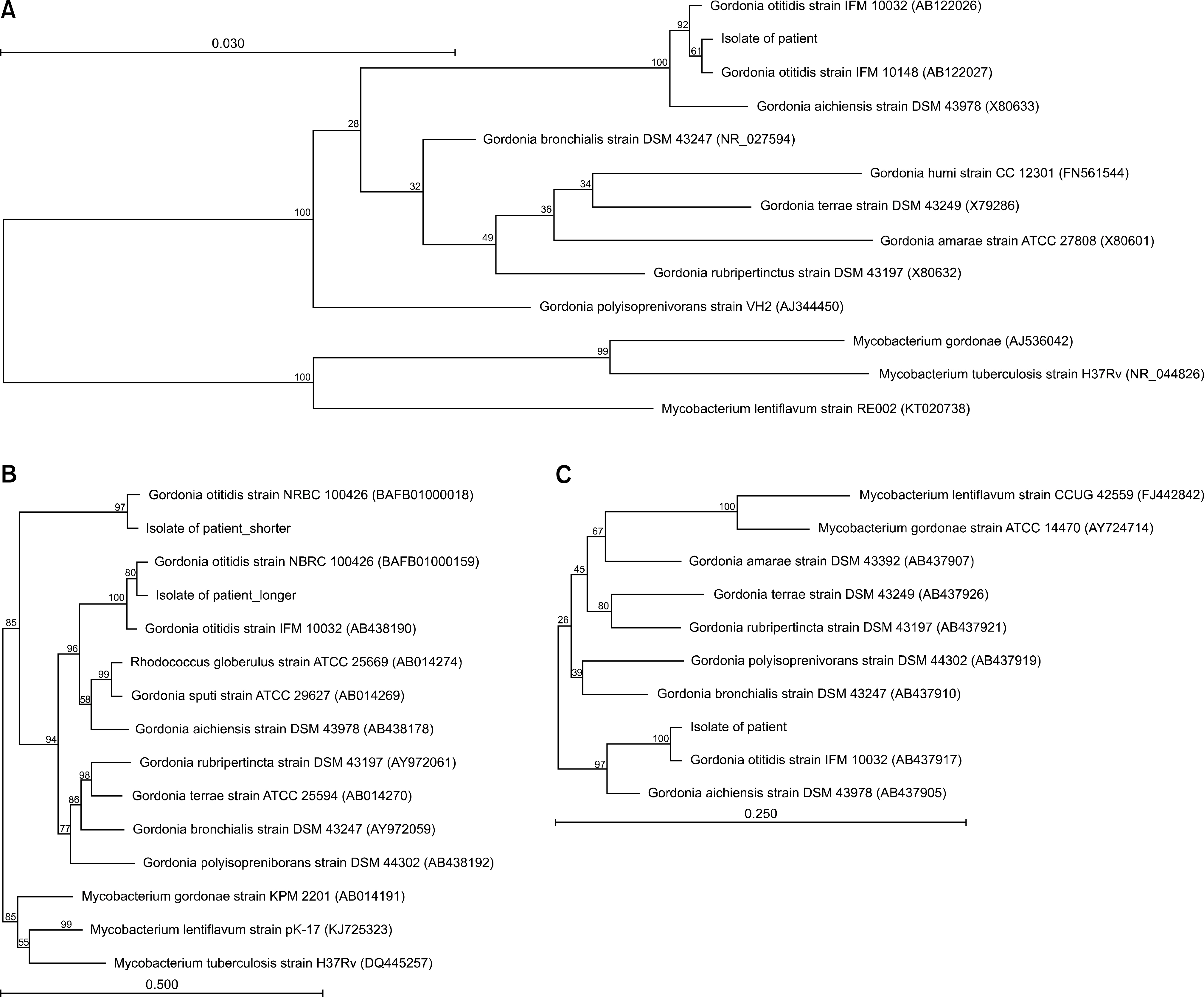Ann Clin Microbiol.
2017 Mar;20(1):13-16. 10.5145/ACM.2017.20.1.13.
A Case of Chronic Gordonia otitidis Lung Infection Initially Regarded as Nontuberculous Mycobacterial Lung Disease
- Affiliations
-
- 1Department of Laboratory Medicine, Pusan National University School of Medicine, Busan, Korea. socioliberal@yahoo.co.kr
- 2Department of Internal Medicine, Pusan National University School of Medicine, Busan, Korea. yskim@pusan.ac.kr
- KMID: 2373000
- DOI: http://doi.org/10.5145/ACM.2017.20.1.13
Abstract
- The genus Gordonia is one of the mycolic acid-containing aerobic actinomycetes. This genus has 38 named species that are widespread in the natural environment; however, Gordonia species rarely cause human infections. A 76-year-old woman presented with cough and sputum for over 1 year and was suspected of having nontuberculous mycobacterial (NTM) lung disease. An NTM isolate from the sputum was initially identified as Mycobacterium lentiflavum or Mycobacterium genavense by genotypic identification targeting internal transcribed spacer (ITS). However, the isolate was finally confirmed as Gordonia otitidis by sequencing of 16S rRNA, gyrB and secA1 genes. In patients with suspected NTM lung disease, the etiologic agent might be an organism other than NTM such as G. otitidis but still be identified as NTM without sequencing of 16S rRNA or other genes. Especially in case that a possible NTM isolate is identified as M. lentiflavum or M. genavense by the genotypic method targeting ITS, additional genotypic tests such as sequencing of 16S rRNA and other genes would be necessary for more reliable identification.
MeSH Terms
Figure
Reference
-
References
1. Kang Y, Takeda K, Yazawa K, Mikami Y. Phylogenetic studies of Gordonia species based on gyrB and secA1 gene analyses. Mycopathologia. 2009; 167:95–105.
Article2. Arenskötter M, Bröker D, Steinbüchel A. Biology of the metabolically diverse genus Gordonia. Appl Environ Microbiol. 2004; 70:3195–204.3. Kim R and Reboli AC. Other coryneform bacteria and Rhodo-cocci. Bennett JE, Dolin R, Blaser MJ, Mandell GL, Douglas GR, editors. Mandell, Douglas, and Bennett's principles and practice of infectious diseases. 8th ed.Philadelphia: Saunders;2015. p. 2381.4. Blaschke AJ, Bender J, Byington CL, Korgenski K, Daly J, Petti CA, et al. Gordonia species: emerging pathogens in pediatric patients that are identified by 16S ribosomal RNA gene sequencing. Clin Infect Dis. 2007; 45:483–6.
Article5. Iida S, Taniguchi H, Kageyama A, Yazawa K, Chibana H, Murata S, et al. Gordonia otitidis sp. nov., isolated from a patient with external otitis. Int J Syst Evol Microbiol. 2005; 55:1871–6.
Article6. Shen FT, Lu HL, Lin JL, Huang WS, Arun AB, Young CC. Phylogenetic analysis of members of the metabolically diverse genus Gordonia based on proteins encoding the gyrB gene. Res Microbiol. 2006; 157:367–75.
Article7. Ma TK, Chow KM, Kwan BC, Lee KP, Leung CB, Li PK, et al. Peritoneal-dialysis related peritonitis caused by Gordonia species: report of four cases and literature review. Nephrology (Carlton). 2014; 19:379–83.
- Full Text Links
- Actions
-
Cited
- CITED
-
- Close
- Share
- Similar articles
-
- Respiratory Review of 2009: Nontuberculous Mycobacterium
- Nontuberculous Mycobacterial Lung Disease Caused by Mycobacterium shinjukuense: The First Reported Case in Korea
- A Case of Welder's Lung Disease and Concurred Non-Tuberculotic Mycobacterial Infection Confirmed with Thoracoscopic Lung Biopsy
- Chronic Large Non Healing Ulcer: Non-Tuberculous Mycobacterial Infection of the Laryngopharynx
- Diagnosis of Pulmonary Tuberculosis and Nontuberculous Mycobacterial Lung Disease in Korea


